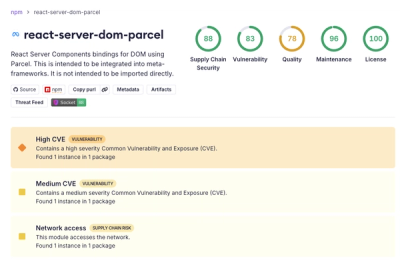
Security News
New React Server Components Vulnerabilities: DoS and Source Code Exposure
New DoS and source code exposure bugs in React Server Components and Next.js: what’s affected and how to update safely.
class-mapper
Advanced tools
![]()
A easy to use way to map any ugly backend structures into clean TypeScript/ES6 models.
Inspired typestack class-transformer
Made with ❤️ by w3tech

Are you tired of ugly and weird backend structures which makes it challenging to work with in your application 🤯? Here comes a solution 🎉! Just use class-mapper to map all weird structures into TypeScript and ES6 models 👉 YOU 🤗 like to work with in your web frontend or Node.js application and not backend guys 🤪.
Try it!! We are happy to hear your feedback or any kind of new features.


npm install class-mapper --save
or with yarn
yarn add class-mapper
<html>
<head>
<script src="node_modules/class-mapper/dist/class-mapper.js"></script>
</head>
</html>
This method maps a source class to your target class
import {mapClasses, MapFromSource, PropertyType} from 'class-mapper';
/**
* Source classes
*/
abstract class SourcePersonModel {
public name1: string;
public name2: string;
}
class SourceCarModel {
public attribute1: string;
public attribute2: string;
}
class SourceCustomerModel extends SourcePersonModel {
public car1!: SourceCarModel[];
}
const sourceUser: SourceCustomerModel = new SourceCustomerModel();
/**
* Target classes
*/
abstract class TargetPersonModel {
@MapFromSource((sourceUser: SourcePersonModel) => sourceUser.name1)
public firstName!: string;
@MapFromSource((sourceUser: SourcePersonModel) => sourceUser.name2)
public lastName!: string;
}
class TargetCarModel {
@MapFromSource((sourceCar: SourceCarModel) => sourceCar.attribute1)
public manufacturer!: string;
@MapFromSource(sourceCar: SourceCarModel) => sourceCar.attribute2)
public model!: string;
}
class TargetCustomerModel extends TargetPersonModel {
@PropertyType(TargetCarModel)
@MapFromSource((sourceUser: SourcePersonModel) => sourceUser.car1)
public cars!: TargetCarModel[];
}
const targetUser: TargetCustomerModel = mapClasses(TargetCustomerModel, sourceUser);
groups to exclude propertiesWith groups array, you can exclude properties from mapping. MapFromSource decorators with no groups option will always be mapped.
import {mapClasses, MapFromSource, PropertyType} from 'class-mapper';
/**
* Source class
*/
abstract class SourcePersonModel {
public name1: string;
public name1: string;
}
/**
* Target class
*/
const firstNameOnly = 'first-name-only';
const lastNameOnly = 'last-name-only';
abstract class TargetPersonModel {
@MapFromSource((sourceUser: SourcePersonModel) => sourceUser.name1, { groups: [firstNameOnly] })
public firstName!: string;
@MapFromSource((sourceUser: SourcePersonModel) => sourceUser.name2, { groups: [lastNameOnly] })
public lastName!: string;
}
const targetUser: TargetCustomerModel = mapClasses(TargetCustomerModel, sourceUser, { groups: [lastNameOnly] });
enabled to exclude propertiesWith enabled you can exclude conditionally properties. MapFromSource decorators with no enabled option will always be mapped.
import {mapClasses, MapFromSource, PropertyType} from 'class-mapper';
/**
* Source class
*/
abstract class SourcePersonModel {
public name1: string;
public name1: string;
}
/**
* Target class
*/
abstract class TargetPersonModel {
@MapFromSource((sourceUser: SourcePersonModel) => sourceUser.name1, { enabled: (sourceUser: SourcePersonModel) => !!sourceUser.name1 })
public firstName!: string;
@MapFromSource(sourceUser => sourceUser.name2, { enabled: (sourceUser: SourcePersonModel) => !!sourceUser.name2 })
public lastName!: string;
}
const targetUser: TargetCustomerModel = mapClasses(TargetCustomerModel, sourceUser);
FAQs
Mapper for ES2015 and TypeScript classes
The npm package class-mapper receives a total of 155 weekly downloads. As such, class-mapper popularity was classified as not popular.
We found that class-mapper demonstrated a not healthy version release cadence and project activity because the last version was released a year ago. It has 1 open source maintainer collaborating on the project.
Did you know?

Socket for GitHub automatically highlights issues in each pull request and monitors the health of all your open source dependencies. Discover the contents of your packages and block harmful activity before you install or update your dependencies.

Security News
New DoS and source code exposure bugs in React Server Components and Next.js: what’s affected and how to update safely.

Security News
Socket CEO Feross Aboukhadijeh joins Software Engineering Daily to discuss modern software supply chain attacks and rising AI-driven security risks.

Security News
GitHub has revoked npm classic tokens for publishing; maintainers must migrate, but OpenJS warns OIDC trusted publishing still has risky gaps for critical projects.